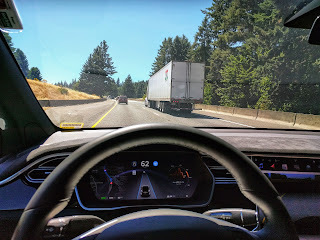How Does Self Driving Cars Work
 |
Waymo undergoing testing in the San Francisco Bay Area |
 |
| Tesla Autopilot is classified as an SAE Level 2 system By Ian Maddox - Own work, CC BY-SA 4.0, https://commons.wikimedia.org/w/index.php?curid=67227170 |
Sensors are an essential component of self-driving cars. These devices are used to detect and interpret the vehicle's surroundings. The most commonly used sensors in autonomous vehicles include cameras, lidar, radar, and ultrasonic sensors. Cameras can capture visual information, such as traffic lights and road signs, while lidar, radar, and ultrasonic sensors are used to detect the presence of other vehicles and obstacles.
 |
| Cruise Automation self-driving car with five Velodyne LiDAR units on the roof By Dllu - Own work, CC BY-SA 4.0, https://commons.wikimedia.org/w/index.php?curid=63450446 |
 |
| An ultrasonic parking sensor (circular) mounted on a vehicle bumper By Basotxerri - Own work, CC BY-SA 4.0, https://commons.wikimedia.org/w/index.php?curid=53945732 |
The data collected by these sensors is then processed by the car's software. The software uses this data to make decisions about how the vehicle should operate, such as when to accelerate, brake, or turn. The software uses a combination of machine learning algorithms and pre-programmed rules to make these decisions. The car's computer system is constantly analyzing the data and making adjustments to the car's operation to ensure a safe and efficient ride.
In addition to sensors and software, self-driving cars also have mechanical systems that allow them to navigate and operate on the road. These systems include steering, braking, and acceleration systems, all of which are controlled by the car's computer. The computer uses the data from the sensors to make decisions about how these systems should be used.


Comments
Post a Comment